No products in the cart.
News, News Holiday
Learn 5 Lesser-known Facts St. Patrick’s Day
Are you ready to learn some fun and friendly Facts St. Patrick’s Day? In this article, we’ll explore five lesser-known but fascinating details about this holiday, and share some exciting ideas for how you can celebrate. Don’t forget to subscribe to our newsletter for the latest blog posts!
Contents
1. Facts St. Patrick’s Day Wasn’t Even Irish
Contrary to popular belief, St. Patrick was not Irish. He was actually born in Britain and kidnapped by Irish raiders when he was a teenager. He spent six years as a slave in Ireland before escaping and returning to Britain. After becoming a priest, he returned to Ireland to spread Christianity and eventually became the patron saint of the country.
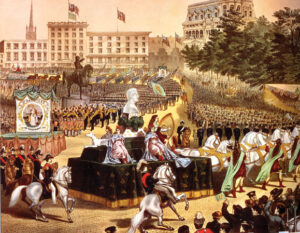
It is a Lesser-known Facts St. Patrick’s Day, the patron saint of Ireland, was not actually Irish. He was born in Britain, and as a teenager, he was kidnapped by Irish raiders and taken to Ireland as a slave. After six years, he escaped and returned to Britain, where he became a priest. Later, he returned to Ireland with the mission of spreading Christianity and converting the pagan Irish to Christianity.
Over time, St. Patrick became the patron saint of Ireland, and his life and legacy are celebrated each year on St. Patrick’s Day. Despite not being Irish, St. Patrick is revered in Ireland as a symbol of the country’s rich history and culture.
2. The First St. Patrick’s Day Parade Was in America
While St. Patrick’s Day is a national holiday in Ireland, the first parade to celebrate the holiday was actually held in the United States. In 1762, Irish soldiers serving in the English military marched through New York City to honor their patron saint. Today, St. Patrick’s Day parades are held in cities all over the world.
St. Patrick’s Day is a national holiday in Ireland and is celebrated around the world, but did you know that the first St. Patrick’s Day parade was actually held in the United States?
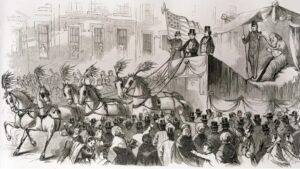
The inaugural parade was held in New York City on March 17, 1762, when a group of Irish soldiers serving in the English military marched through the city in honor of their patron saint. The parade was a way for Irish immigrants to connect with their roots and celebrate their cultural heritage, and it quickly became an annual tradition in the city.
As Irish immigrants began to settle in other parts of the United States, they brought the St. Patrick’s Day parade tradition with them. By the mid-19th century, parades were being held in cities such as Boston and Philadelphia, and they continued to grow in popularity.
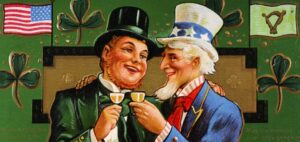
Today, St. Patrick’s Day parades are held in cities and towns all over the world, and they are often the highlight of the holiday celebration. The parades feature elaborate floats, marching bands, bagpipers, and dancers, and participants are often decked out in green, the color associated with the holiday.
In addition to the parades, many cities also hold other St. Patrick’s Day celebrations, such as festivals, concerts, and street fairs. These events often feature traditional Irish music, food, and drink, as well as activities for children and families.
St. Patrick’s Day is a beloved holiday that celebrates Irish culture and heritage, and the tradition of the parade has become an important part of the celebration. Whether you are Irish or not, the St. Patrick’s Day parade is a great way to connect with the community and celebrate the rich history and culture of Ireland.
3. The Color Associated With St. Patrick’s Day Wasn’t Always Green
Green is now the color most associated with St. Patrick’s Day, but it wasn’t always that way. Originally, the color associated with St. Patrick was blue. Green only became popular after the Irish independence movement in the late 18th century, when it became a symbol of Irish pride and nationalism.
The color green is strongly associated with St. Patrick’s Day, but it wasn’t always the case. In fact, blue was the original color associated with the holiday.
In early depictions of St. Patrick, he was often shown wearing blue robes. This association with blue continued for many years, and it wasn’t until the 17th century that green became the dominant color.
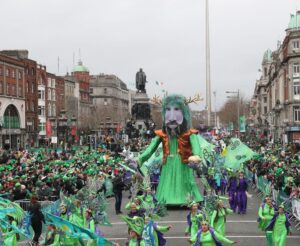
The shift towards green is often attributed to Ireland’s landscape, which is famously lush and green. Over time, the color green became more closely associated with Irish culture and identity, and it eventually replaced blue as the color of St. Patrick’s Day.
The color green is now ubiquitous on St. Patrick’s Day, with people wearing green clothing, decorating their homes and businesses with green decorations, and even dyeing food and drink green. The tradition of wearing green on St. Patrick’s Day is thought to have originated as a way to show solidarity with Ireland and its people.
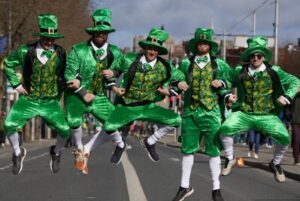
In addition to green, other colors have also been associated with St. Patrick’s Day. For example, gold is often used in decorations and attire, as it is associated with the famous pot of gold at the end of the rainbow. Additionally, white has been used to represent the white band of the Irish flag, and orange has been used to represent the Protestant minority in Ireland.
While the color green is now firmly associated with St. Patrick’s Day, it’s interesting to consider how this tradition developed over time. The shift from blue to green is just one example of how cultural traditions can evolve and change over time, and it’s a reminder of the rich history and culture that is celebrated on St. Patrick’s Day.
4. Facts St. Patrick’s Day Was Once a Dry Holiday
Believe it or not, St. Patrick’s Day was once a dry holiday in Ireland. Up until the 1970s, all pubs and bars were closed on March 17th to mark the solemnity of the holiday. However, in recent years, the Irish government has embraced St. Patrick’s Day as a way to boost tourism and now encourages the consumption of alcohol on the holiday.
St. Patrick’s Day, also known as the Feast of St. Patrick, is a cultural and religious holiday that celebrates the patron saint of Ireland. It is typically observed on March 17th and is marked by parades, festivals, and the wearing of green clothing. However, many people are unaware that St. Patrick’s Day was once a dry holiday, meaning that the consumption of alcohol was not permitted.
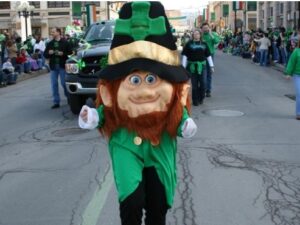
The origins of St. Patrick’s Day date back to the early 17th century when it was made an official feast day in the Catholic Church. At the time, Ireland was a predominantly Catholic country, and St. Patrick’s Day was an important religious observance. However, the holiday was not associated with drinking or partying, as it is today.
The idea of St. Patrick’s Day as a drinking holiday is a relatively modern development. In the 19th century, Irish immigrants began to celebrate St. Patrick’s Day in the United States as a way of expressing their cultural identity. However, these celebrations were often rowdy and involved heavy drinking, which led to negative stereotypes of the Irish as being drunken and disorderly.
As a result, many Irish-American leaders, including members of the Catholic Church, began to advocate for a more restrained celebration of St. Patrick’s Day. In the early 20th century, many cities and towns began to enforce laws that prohibited the sale and consumption of alcohol on March 17th.

The push for a dry St. Patrick’s Day continued into the 1920s and 1930s, as the Prohibition era made the sale and consumption of alcohol illegal throughout the United States. Even after Prohibition was repealed in 1933, some communities continued to enforce dry St. Patrick’s Day laws.
Today, St. Patrick’s Day is celebrated as a joyous occasion that often involves drinking and partying. However, the history of St. Patrick’s Day as a dry holiday is a reminder that cultural traditions can evolve over time, and that the way we celebrate a holiday can change based on social and political factors.
5. The Chicago River Is Dyed Green Every St. Patrick’s Day
In Chicago, the city celebrates St. Patrick’s Day by dyeing the Chicago River bright green. The tradition began in 1962, when city officials wanted to find a way to celebrate the holiday in a unique way. They decided to dye the river green using a secret recipe that only a few people know.
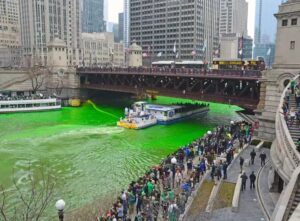
The tradition of dyeing the Chicago River green on St. Patrick’s Day is a unique and beloved tradition that dates back to the early 1960s. It is a way for the city of Chicago to celebrate St. Patrick’s Day in a festive and colorful way, and it has become an iconic part of the holiday in the city.
The origins of the tradition are somewhat murky, but it is generally believed to have started with the Plumbers Local Union No. 110. The union’s members would gather on St. Patrick’s Day and dye the river green using a vegetable dye. The first time this was done, the dye was accidentally spilled into the river, turning it an unexpected shade of green. But the effect was so striking that the union decided to do it again the following year, this time intentionally.
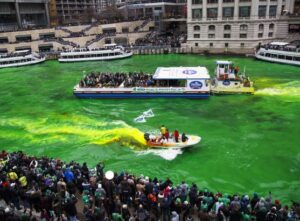
Over the years, the tradition of dyeing the river green has grown and become more sophisticated. Today, the dye used to color the river is a proprietary formula that is mixed in large vats before being poured into the river. The exact formula is a closely guarded secret, but it is known to be a non-toxic vegetable-based dye that is safe for the environment.
The process of dyeing the river green is now a major event in Chicago, drawing crowds of thousands of spectators who line the banks of the river to watch the transformation take place. The dyeing is typically done early in the morning on St. Patrick’s Day, and the river remains green for several hours before gradually fading back to its normal color.
The tradition of dyeing the Chicago River green is a testament to the city’s Irish heritage and its enthusiasm for St. Patrick’s Day. It is also a testament to the creativity and ingenuity of the people of Chicago, who have turned a simple idea into a beloved and iconic tradition that is recognized around the world.
See more:
- 12 Best St Patrick’s Day Food Ideas
- Top 10 Funny Patrick’s day T-Shirts For You
- Top 8 Cool St Patrick’s Day Mickey Mouse Shirt

IDEAS & ADVICE
Is Iron Man Marvel Or DC: Exploring The Universes Of Tony Stark
Iron Man, one of Marvel Comics’ most iconic superheroes, has captivated audiences worldwide with his [...]
Can Scarlet Witch Beat Thanos? Exploring Her Power In The Marvel Universe
In the Marvel Cinematic Universe, few characters evoke as much intrigue and debate as Scarlet [...]
How Many Punisher Movies Are There? A Comprehensive Look At Frank Castle’s Cinematic Journey
The Punisher, known for his brutal vigilante justice, is one of Marvel Comics’ most iconic [...]
How Old Is Scarlet Witch? Unveiling The Age Of Marvel’s Mystical Heroine
Scarlet Witch, also known as Wanda Maximoff, is a key character in the Marvel Universe, [...]
Does Scarlet Witch Die? Exploring The Fate Of Marvel’s Powerful Sorceress
Scarlet Witch, or Wanda Maximoff, is one of Marvel Comics’ most powerful and enigmatic characters. [...]
Is Scarlet Witch A Mutant? Exploring Wanda Maximoff’s Origins In The Marvel Universe
Scarlet Witch, also known as Wanda Maximoff, is a complex and powerful character in the [...]
Who Plays As Deadpool? Exploring The Actor Behind The Merc With A Mouth
Deadpool, Marvel Comics’ irreverent and fourth-wall-breaking anti-hero, has become a cultural phenomenon known for his [...]
Is Wolverine Dead? Exploring The Fate Of Marvel’s Iconic Mutant
Wolverine, also known as Logan, is one of Marvel Comics’ most beloved and enduring characters, [...]